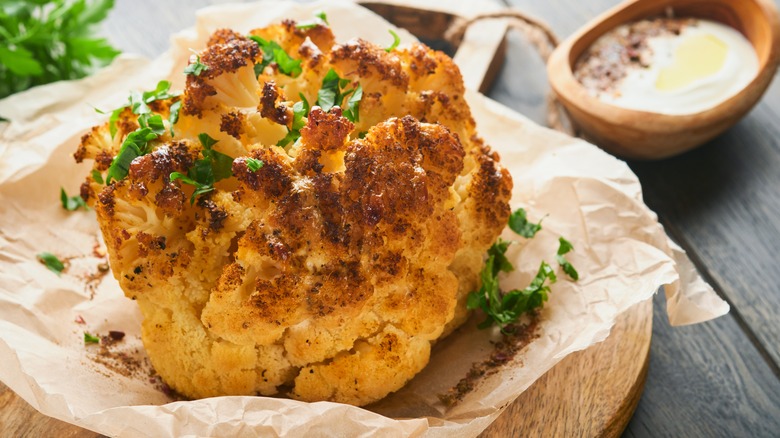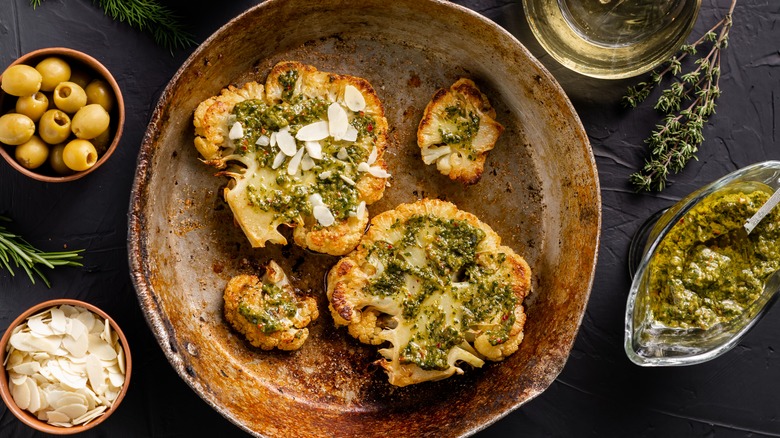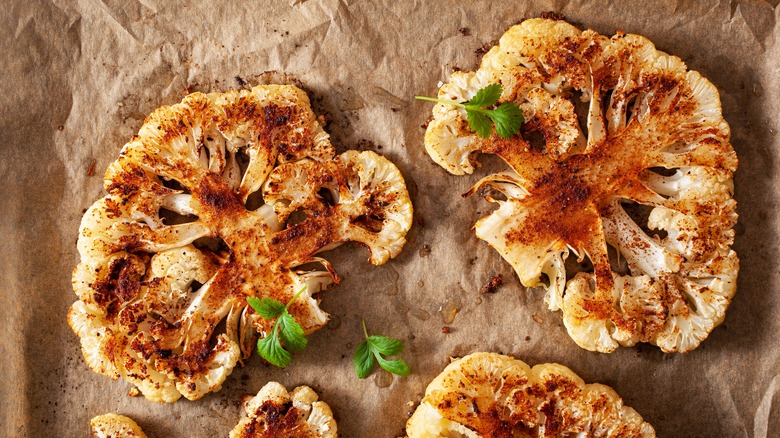The Step You Shouldn't Skip When Roasting A Whole Cauliflower
Few vegetables are as versatile as the hearty cauliflower. From the classic cauliflower T-bone steak to the creamiest cauliflower soup, this vegetable can be transformed in a variety of ways to suit your meal of choice. However, among the many methods of cooking this cruciferous vegetable, roasting the whole cauliflower head remains one of the best ways to maximize not only its flavor but also its soft, melt-in-your-mouth texture. The recipe for this dish is relatively straightforward, but if there's one thing you should always do before roasting whole cauliflower, it's blanching it in salt water.
When people roast whole cauliflower, they often merely rub oil and seasonings on the outside of the vegetable right before cooking. This results in the inside of the dish coming out under-seasoned in comparison to the crunchy, flavor-packed exterior. By blanching in salted water, you essentially give the interior of your cauliflower a chance to season itself before the roasting process, creating a dish that has flavor throughout its entire body. Blanching also helps kickstart the cooking process throughout the entire vegetable, which helps avoid burning the outside when using high-heat cooking methods such as searing, roasting, or frying.
Blanching in salt water infuses flavor
While blanching is a relatively simple technique, there are several things to keep in mind when blanching cauliflower in particular. Due to the vegetable's large size, you must find a pot large enough to fully submerge the whole cauliflower in salted water. A large saucepan or an enameled cast iron pot should be deep enough to completely cover most cauliflower heads, but if you don't have a large enough pot, consider purchasing a smaller whole cauliflower from your local supermarket.
When blanching, wait for the water to reach a rolling boil before adding the vegetable. Introducing cauliflower to the water as it heats could result in premature or uneven cooking, potentially spoiling your recipe and leading to burning or a mushy end product. Similarly, this could cause the exterior of your cauliflower to become too soft, preventing it from properly adhering to your spice rub. Remember: Blanching is distinct from boiling, so err on the side of caution and transfer your whole cauliflower into your ice bath after two to four minutes, depending on its size.
Other tips when roasting whole cauliflower
Keep in mind that roasting a cauliflower is not a quick process; it can take an hour from start to finish. Of course, if you prefer your cauliflower al dente, you can take it out of the oven as soon as it starts to turn golden brown. This may save you a few minutes, and you can check its doneness by piercing its side with a sharp knife.
Because roasting cauliflower takes a significant amount of time, it's advisable to keep heat-sensitive ingredients away from your seasoning rub. This typically includes any finishing oils (such as high-quality olive oil or truffle oil) and delicate fresh herbs like basil leaves, as they can burn quickly under high heat. Instead, use these ingredients as garnishes, sprinkling them on your whole roasted cauliflower after cooking.
If you're looking to enhance the dish, vinegars are among the most commonly used acids in the kitchen to brighten and balance flavors. You can either drizzle some over your cauliflower after slicing it into steaks, or, if you have the time, reduce it into a vinaigrette sauce that will add some sweetness and tang to the dish.



